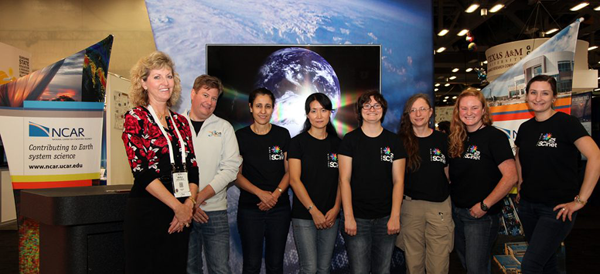Raising the visibility of women in IT
UCAR helps assemble networking team for supercomputing conference
Oct 17, 2016 - by Staff
Oct 17, 2016 - by Staff
October 17, 2016 | To provide a boost to women working in information technology, the University Corporation for Atmospheric Research (UCAR) is helping to bring together a team of women who will help build and operate a high-capacity network at a major supercomputing conference.
The Women in IT Networking at SC program, or WINS, is a collaboration among UCAR, the U.S. Department of Energy’s Energy Sciences Network, and the Pennsylvania-based Keystone Initiative for Network Based Education and Research. Following a national competition, WINS selected seven women who work in IT departments at universities and national labs around the country to help build and operate SCinet, the very high capacity network at the SC16 international supercomputing conference in Salt Lake City next month.
 For the second year in a row, UCAR will help bring together a team of women to provide technical support at SC, a leading supercomputing conference. UCAR's Marla Meehl (left) and ESnet's Jason Zuraski (second from left) are pictured at last year's conference, meeting with WINS team members. (Photo by Marijke Unger, NCAR.)
For the second year in a row, UCAR will help bring together a team of women to provide technical support at SC, a leading supercomputing conference. UCAR's Marla Meehl (left) and ESnet's Jason Zuraski (second from left) are pictured at last year's conference, meeting with WINS team members. (Photo by Marijke Unger, NCAR.)
"This provides the women with great exposure to the latest in technology, working with some of the top engineers who are out there," said Marla Meehl, manager of the Network Engineering and Telecommunications Section for UCAR and NCAR, the National Center for Atmospheric Research. "It's an opportunity to learn and have exposure to things that they don't work with every day."
Women are increasingly underrepresented in technological fields. A report last year by the American Association of University Women found that the number of U.S. women working in the computing and mathematical professions dropped from 35% in 1990 to just 26% in 2013.
Meehl worked with several other IT experts to launch WINS last year and expand the number of women among the volunteers who design and deliver SCinet. Planning begins more than a year in advance and culminates in a high-intensity, around-the-clock installation in the days leading up to the conference.
"I’m grateful to be one of the WINS grant awardees and participate in SCinet," said Angie Asmus, IT security analyst at Colorado State University. "Because of WINS, I will be able to be mentored by and work with some of the brightest minds in IT. This is an amazing opportunity for me to gain hands-on experience and build important relationships that will be valuable to me as I progress in my career."
Other participants are Denise Grayson, Sandia National Laboratories; Julie Locke, Los Alamos National Laboratory; Kali McLennan, University of Oklahoma: Amber Rasche, North Dakota State University; Jessica Shaffer, Georgia Institute of Technology; Julia Staats, CENIC; and, with separate funding, Indira Kassymkhanova of Lawrence Berkeley National Laboratory.
The WINS participants were chosen from 28 eligible applicants—a big jump from the 19 applications received the previous year. The selection team weighed a variety of factors, looking for applicants who had experience in networking; whose skillset matched their area of interest; whose participation was supported by their institution; and who added to the group’s diversity, whether geographically, institutionally or otherwise.
The WINS awardee selection team, led by Wendy Huntoon of the Keystone Initiative, included Susan Lucas from ESnet, Linda Winkler from Argonne National Labs, Dave Jent from Indiana University, and Florence Hudson from Internet2.
Meehl was able to secure funding from the National Science Foundation for participants from research and education organizations. The Department of Energy is supporting the women from its national laboratories.
“Although there are more jobs in IT, there’s a massive shortage of workers, especially in the number of women in the field,” Meehl said. “It was really fulfilling this year to see a huge jump in the number of really qualified applicants. It was very hard to choose.”
Writer/editor:
David Hosansky, Manager of Media Relations